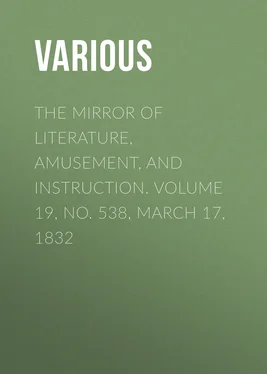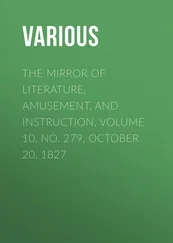Various - The Mirror of Literature, Amusement, and Instruction. Volume 19, No. 538, March 17, 1832
Здесь есть возможность читать онлайн «Various - The Mirror of Literature, Amusement, and Instruction. Volume 19, No. 538, March 17, 1832» — ознакомительный отрывок электронной книги совершенно бесплатно, а после прочтения отрывка купить полную версию. В некоторых случаях можно слушать аудио, скачать через торрент в формате fb2 и присутствует краткое содержание. Жанр: foreign_antique, periodic, Развлечения, foreign_edu, на английском языке. Описание произведения, (предисловие) а так же отзывы посетителей доступны на портале библиотеки ЛибКат.
- Название:The Mirror of Literature, Amusement, and Instruction. Volume 19, No. 538, March 17, 1832
- Автор:
- Жанр:
- Год:неизвестен
- ISBN:нет данных
- Рейтинг книги:3 / 5. Голосов: 1
-
Избранное:Добавить в избранное
- Отзывы:
-
Ваша оценка:
- 60
- 1
- 2
- 3
- 4
- 5
The Mirror of Literature, Amusement, and Instruction. Volume 19, No. 538, March 17, 1832: краткое содержание, описание и аннотация
Предлагаем к чтению аннотацию, описание, краткое содержание или предисловие (зависит от того, что написал сам автор книги «The Mirror of Literature, Amusement, and Instruction. Volume 19, No. 538, March 17, 1832»). Если вы не нашли необходимую информацию о книге — напишите в комментариях, мы постараемся отыскать её.
The Mirror of Literature, Amusement, and Instruction. Volume 19, No. 538, March 17, 1832 — читать онлайн ознакомительный отрывок
Ниже представлен текст книги, разбитый по страницам. Система сохранения места последней прочитанной страницы, позволяет с удобством читать онлайн бесплатно книгу «The Mirror of Literature, Amusement, and Instruction. Volume 19, No. 538, March 17, 1832», без необходимости каждый раз заново искать на чём Вы остановились. Поставьте закладку, и сможете в любой момент перейти на страницу, на которой закончили чтение.
Интервал:
Закладка:
Various
The Mirror of Literature, Amusement, and Instruction / Volume 19, No. 538, March 17, 1832
THE ARBALEST, OR CROSS-BOW
THE ARBALEST, OR CROSS-BOW
The Bow would appear to have been in most ancient nations the principal implement of war; and to keep alive this "mystery of murder," archery, or the art of shooting with a bow and arrow, seems to have been a favourite pastime in days of peace. In no country, however, has archery been more encouraged than in this island; wherefore the English archers became the best in Europe, and procured many signal victories. Tributary as have been the bow and arrow to some of the brightest scenes in our history, it is not surprising that its exercise should have become cherished among us as an amusement. Strutt tells us that in the early ages of chivalry, the usage of the bow was considered as an essential part of the education of a young man who wished to make a figure in life. Hence the long-bow and cross-bow have been and are playthings in the hands of youth; and would that they had only been the toys of the playground instead of leading men to slaughter each other for the costly toys of the game of life. It is chiefly to the use of the cross-bow that we propose to confine ourselves upon the present occasion.
The arbalest, or cross-bow, was not only much shorter than the long-bow, but fastened also upon a stock, and discharged by means of a catch or trigger, which Mr. Strutt reasonably enough thinks gave rise to the lock on the modern musket. The old logicians illustrate the distinction in their quaintest fashion. Bayle, explaining the difference between testimony and argument, uses this laconic simile, "Testimony is like the shot of a long-bow, which owes its efficacy to the force of the shooter; argument is like the shot of the cross-bow, equally forcible, whether discharged by a dwarf or a giant."
The arbalest is said by some writers to be of Italian origin. Verstegan says it was introduced here by the Saxons, but was neglected till again brought into use by William the Conqueror, at the battle of Hastings. No mention is made of bowmen among the troops of Harold; but we read that the Norman army was fronted by "footmen clothed in light armour, worn over a gilted cassock, and bearing either long-bows or steel cross-bows." Harold himself had his eye struck by an arrow, notwithstanding which he continued to fight at the head of his army. Cross-bows were afterwards prohibited by the second Lateran Council, anno 1139, as hateful to God, and unfit to be used among Christians; in consequence whereof they were laid aside till the reign of Richard the First, who again introduced them, and was himself killed by an arrow or quarrel, discharged from a cross-bow at the siege of the Castle of Chalus. 1 1 Notes by Mr. Grose, the antiquarian, in Selections from Gentleman's Magazine , vol. i. In the Archaeologia . vol. vi. we find it stated that "Artillery ( artillérie ) is a French term signifying Archery , as the king's bowyer is in that language styled artillier du roy; and from that nation the English seem to have learnt at least the cross-bow archery."
Cross-bows shot darts called quarrels, or quarreaux , or quadrels , and in English bolts : they were headed with solid, square pyramids of iron, and sometimes trimmed with brass instead of feathers. According to Sir John Smith a cross-bow would kill point blank 60 yards, and if elevated above 160. There was an officer styled Balistrarius Regius ; and several estates were held by the service of delivering a cross-bow and thread to make the string, when the king passed through certain districts. These you will find in Blount's Tenures and Jacob's Law Dictionary. 2 2 Grose.
We find that the pay of a cross-bowman, in the reign of Edward II., was sixpence per diem . 3 3 Grose.
Few notices of archery are, however, upon record till an order by Edward III. in the 15th year of his reign, to the sheriffs of most of the English counties, to provide bows and arrows for the intended war against France: these orders, however, relate to the long-bow. In the famous battle of Crecy, fought in 1346, our chroniclers state that we had 2,800 archers, who were opposed to about the same number of the French; which, together with a circumstance to be immediately mentioned, seems to prove that by this time we used the long-bow whilst the French archers shot with the arbalest. The circumstance alluded to is as follows:—Previously to the engagement there fell a heavy rain, which is said to have much damaged the bows of the French, or rather the strings of them. Now, the long-bow, when unstrung, may be conveniently covered, so as to prevent the rain injuring it; nor is there scarcely any addition to the weight from a case; whereas the arbalest is of a most inconvenient form to be sheltered from the weather. It is also stated 4 4 Hist. England, by Sir James Mackintosh, vol. i.
that, at Crecy, "the Genoese archers, fatigued by their heavy cross-bows, in a sultry and tempestuous march, rushed forward with loud cries to attack the English bowmen, who were the strength of Edward's army. These last stood still; even on the second charge they stirred not one foot! When they got within shot of their foes, they let fly their arrows so quickly that they came like snow. The Genoese fled, and some of the heavy-armed troops were involved in their confusion." At Crecy the English ascribed their victory to their archers. The battle of Poictiers, fought in 1356, was gained by the same means. In 1417, Henry V. attributed his splendid victory at Agincourt to the archers, and directed the sheriffs of many counties to pluck from every goose six wing-feathers for the purpose of improving arrows, which were to be paid for by the King. In 1421, though the French had been defeated at Crecy, Poictiers, and Agincourt, by the English archers, yet they still continued the use of the cross-bow; for which reason Henry V., as Duke of Normandy, confirms the charters and privileges of the balistarii , who had been long established as a fraternity in his city of Rouen.
We now meet with several enactments by Edward IV. for the appointment of bowmen with the long-bow; but we pass over these and other records to the 19th year of the reign of Henry VII., who forbade the use of the cross-bow, because "the long-bow had been much used in this realme, whereby honour and victory had been gotten against outward enemies, the realm greatly defended, and much more the dread of all Christian princes by reason of the same." Statutes for the promotion of archery with the long-bow are now very frequent; but the cross-bow is proscribed in the same proportion: and, in the time of Henry VIII. a penalty of ten pounds was inflicted on every one who kept a cross-bow in his house.
Though archery continued to be encouraged by the king and legislature for more than two centuries after the first knowledge of the effects of gunpowder, yet by the latter end of the reign of Henry VIII., it seems to have been partly considered as a pastime.
From this period we pass to the date of the annexed CUTS, for which we are indebted to the research of an ingenious Correspondent, with the antiquarian subscription of "JONATHAN OLDBUCK," 5 5 Dated from Clarence-terrace, Regent's-park.
who appends to his sketches the following historical notice:
"After the destruction of the Spanish Armada, fears being entertained lest the King of Spain should (out of revenge) send an emissary to attempt the life of Queen Elizabeth, a number of noblemen of the Court formed themselves into a body guard for the protection of her person, and under the denomination of the 'Companie of Liege Bowmen of the Queene,' had many privileges conferred upon them. The famous Dudley, Earl of Leicester, was captain of this company, which was distinguished by the splendour of its uniform and accoutrements. Upon the accession of James I. the company was disbanded, although those who composed it retained the privileges which had been conferred upon them by Elizabeth. Upon the breaking out of the Civil wars Charles reorganized this bodyguard which attended him against the Parliamentary forces, and afterwards emigrated with Charles II. At the Restoration this company was maintained, and under the title of 'Royal Company of Archers' received a new Charter, being the origin of the present 'Royal Artillery Company' of London. About the time of the institution of the Liege Bowmen of the Queen, a new kind of cross-bow was constructed in Holland, by one Vander Foheman, having many advantages over the old one. This he brought to England and it was purchased and adopted by the Company. 6 6 Vide Grose on Ancient Armour. D'Alembert, Encyclopedie. Art. Arbalette.
Интервал:
Закладка:
Похожие книги на «The Mirror of Literature, Amusement, and Instruction. Volume 19, No. 538, March 17, 1832»
Представляем Вашему вниманию похожие книги на «The Mirror of Literature, Amusement, and Instruction. Volume 19, No. 538, March 17, 1832» списком для выбора. Мы отобрали схожую по названию и смыслу литературу в надежде предоставить читателям больше вариантов отыскать новые, интересные, ещё непрочитанные произведения.
Обсуждение, отзывы о книге «The Mirror of Literature, Amusement, and Instruction. Volume 19, No. 538, March 17, 1832» и просто собственные мнения читателей. Оставьте ваши комментарии, напишите, что Вы думаете о произведении, его смысле или главных героях. Укажите что конкретно понравилось, а что нет, и почему Вы так считаете.












